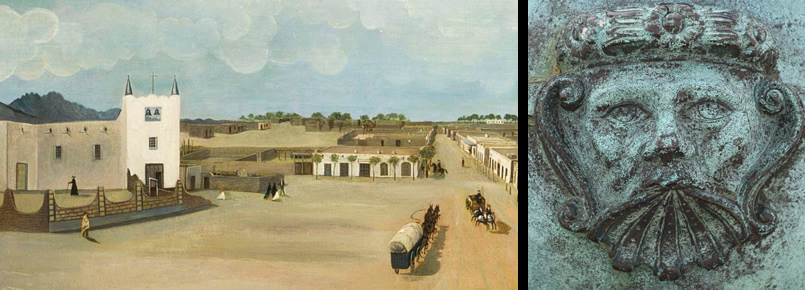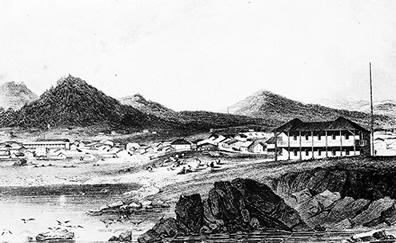

American Latino Heritage
Old Custom House
Monterey, California
 |
Monterey’s Old Custom House, built in 1827, is the oldest government building in California |
Before the Spanish began to explore and colonize the region, the Ohlone populated the Monterey area. The coastal lands were flush with natural resources, fertile soil, and a temperate climate – all qualities that would later attract the Spaniards.
In 1542, Spanish explorer Juan Rodríquez Cabrillo was the first non-Native person to see the wide Monterey Bay in southern California, spotting it from a ship. In 1770, Captain Gaspar de Portolá and Franciscan Father Junípero Serra established the Royal Presidio of Monterey and the San Carlos de Borromeo Mission – the city’s first permanent buildings. The presidio was soon serving as the seat of the Spanish government in the area. By 1776, Monterey became the capital of both Baja (lower) and Alta (upper) California.
Monterey thrived, mainly within the protective walls of the military presidio, until Argentinean revolutionary privateer, Hipólito Bouchard attacked the city in 1818. The conflict would be the only land and sea battle fought on the West Coast. Bouchard sacked the town leaving severe damage in his wake. Over the next decade Monterey remained the capital and slowly rebuilt. Residences and businesses moved beyond the presidio’s walls and the street pattern that is still visible in Monterey today began to develop.
 |
From 1827 until 1846 the custom house (shown at right) levied duty fees on cargo entering the Monterey Bay |
The Custom House in Monterey emerged out of this new period of prosperity. In April of 1822, the city learned that Mexico had won its independence from Spanish rule the year before. California immediately pledged allegiance to the Mexican government. While Spain had prohibited international trade in its territories, the Mexican government opened up its borders and seaports to foreign trade. The purpose of the Custom House was to collect custom duties on foreign goods at the bay, California’s main point of entry.
Constructed in 1827 and perched on the wide bay at Monterey, the Old Custom House was the first government building in California and the earliest government building on the west coast. The building quickly became a critical part of trade and cargo sale during the Mexican Era. A wide variety of goods began to flow into California arriving on ships from American, British, and South American markets. A single vessel involved in California’s popular hide and tallow trade might owe $5,000 to $25,000 in duty fees on just one load of cargo. The collection of custom fees was California’s most important source of revenue during the 19th century.
The growing trade through Monterey launched the city into a new era of heightened prosperity. What had begun as a small presidio grew into a major cosmopolitan community and an attractive destination for American travelers. This growing American presence in 1842 led to greater interest by the United States government in the territory, and by 1844, the United States established an American consulate in Monterey.
Thomas O. Larkin, a New England merchant who came to California in April 1832, was the first and only United States Consul to Mexican-ruled California. When Larkin first moved to Monterey, he quickly became an affluent citizen and developed a successful trading business. Because of his knowledge and position, Secretary of State Buchanan appointed him as Consul. Larkin is considered to be a key player in the eventual annexation of California by the U.S. Larkin's home served as the consulate from 1844 to 1846 and is now listed in the National Register of Historic Places.
 |
Commodore John D. Sloat first raised the American flag over the custom house in 1846, claiming California as a U.S. territory. |
Larkin altered and expanded the single-story Custom House, more than doubling its size. By 1846, the custom house had reached its present form and had two stories, a two story porch veranda, four large contiguous rooms, and a tiled hipped roof. At this same time, Mexico and the United States went to war with each other. Commodore John D. Sloat, commander of the U.S. Pacific squadron, arrived in Monterey during the “Bear Flag Revolt.” He raised the American flag over the Custom House and officially claimed California as U.S. territory.
The Old Custom House served as the American-operated custom house until 1868 and then became a private residence. By the early 1890s, the building was unoccupied and began to deteriorate. In 1900, it became one of California’s earliest preservation projects. The Native Sons of the Golden West completed the original restoration efforts by 1917. In 1929, the building became the first California State Landmark. On January 1, 1930, the State Division of Beaches and Parks took it over and opened it to the public as a museum. In 1960, the Custom House was designated a National Historic Landmark and remains in use as a museum and visitor center.
Visitors to the Old Custom House can tour the building and peruse the historic objects and educational materials there. The building sits within the Monterey Old Town Historic District, itself a National Historic Landmark. The district showcases several dozen 19th-century adobe buildings from both the Spanish and Mexican eras that at one time were the hub of social, economic, and political activities in California. The district is also part of California’s Monterey State Historic Park. A two-mile walking path marked with yellow tiles guides guests through the historic buildings, secret gardens, and gorgeous views. Visitors are welcome to explore the “Monterey Walking Path of History” on their own with the help of an interpretive brochure found online here. Guided tours are available and tickets may be purchased at the Pacific House Museum or by calling the Monterey State Historic Park office at 831-649-7118.
| Plan your visit |
The Old Custom House is a National Historic Landmark and also part of the Monterey Old Town Historic District National Historic Landmark and California’s Monterey State Historic Park. The Custom House is located at 20 Custom House Plaza, Monterey, CA. Click here for the Old Custom House National Historic Landmark file: text and photos. The Custom House is an active museum and is open daily for tours and visitation. For more information, visit the Monterey Historic Park Tour Page website or call the park at 831-649-7118. The Old Custom House has been documented by the National Park Service’s Historic American Buildings Survey. It is also featured in the National Park Service Early History of the California Coast Travel Itinerary as part of the Monterey Old Town Historic District. |